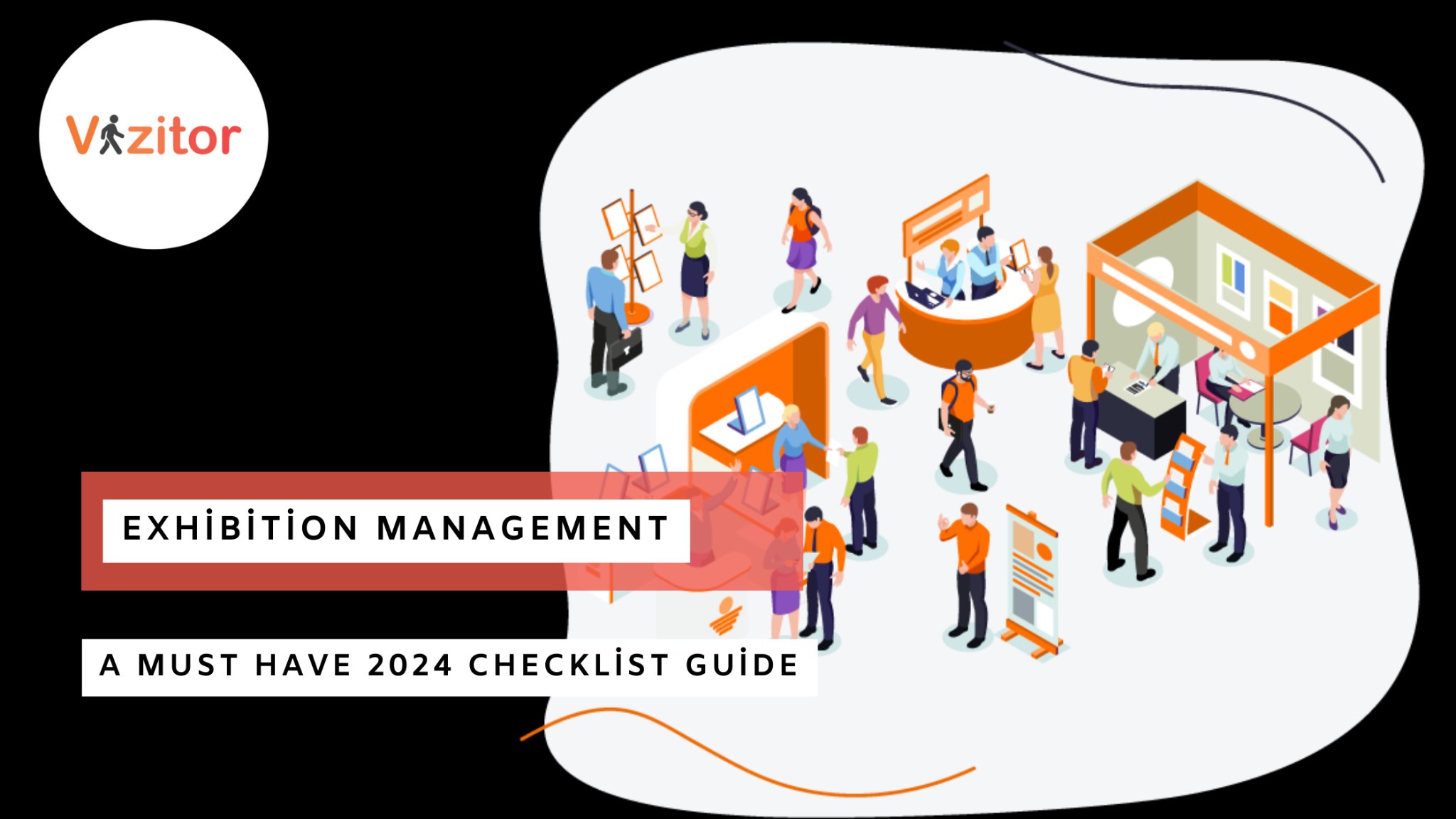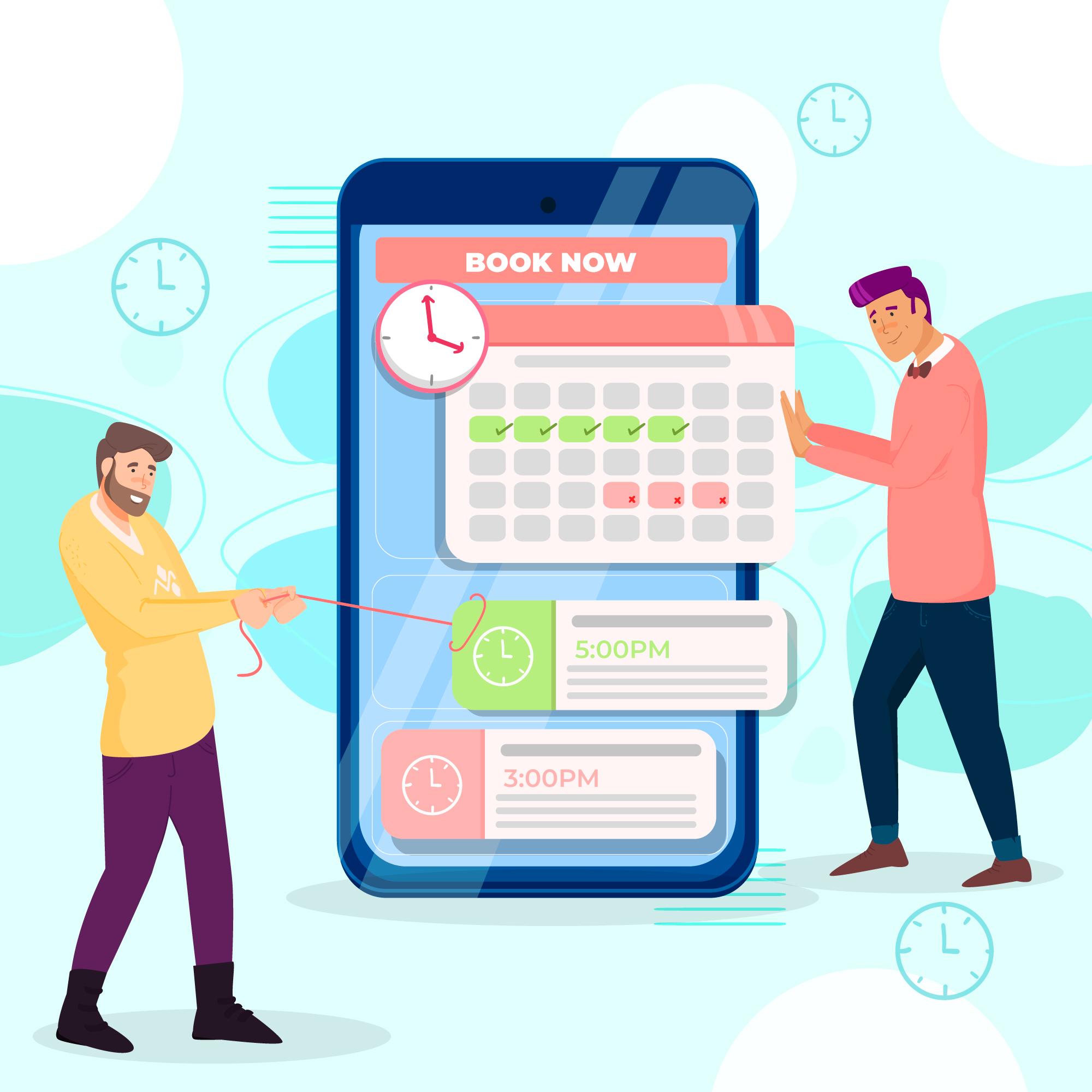Table of Content
Try Vizitor for Free!

Thu, Mar 27, 2025
Read in 14 minutes
Introduction
Did you know that over 85% of trade show exhibitors now consider exhibitions essential to their 2025 marketing strategy? As the landscape of exhibitions continues to evolve, effective exhibition management has become more critical than ever.
Whether it’s a trade exhibition, consumer fair, or a hybrid expo, businesses need a robust exhibition management system to plan, execute, and measure their presence. This guide is your go-to resource for 2025—covering strategy, tools, planning checklists, and the latest trends in exhibition event management.
Exhibition management encompasses everything from booth design and staffing to marketing and follow-up strategies. It’s essential to maximize the return on investment (ROI) from these events. A well-managed exhibition not only attracts potential customers but also strengthens brand presence and creates networking opportunities.
Proper exhibition management ensures that all aspects of participation are seamlessly integrated, from logistics and setup to engagement and lead generation. It helps in aligning the exhibition goals with overall business objectives, ensuring that every aspect of the event is strategically planned and executed.
Moreover, with the increasing competition and the high costs associated with trade shows, having a comprehensive checklist guide for exhibition management in 2024 is indispensable. This guide will help businesses navigate the complexities of exhibition planning, ensuring that they make the most out of every opportunity to showcase their products and services.
Stay tuned as we delve into the must-have checklist for Event Guest Management in 2024, covering all the essential steps to ensure your next event is a resounding success.
What Is Exhibition Management?
Exhibition management is the strategic process of planning, organizing, and executing all aspects of participating in trade shows, exhibitions, and similar events. It involves a series of coordinated activities designed to ensure that a company’s presence at these events is impactful, efficient, and aligned with its business objectives. Here’s a detailed look at what exhibition management entails:
1. Planning and Strategy
- Goal Setting: Establish clear objectives for the exhibition, such as brand awareness, lead generation, or product launches.
- Budgeting: Allocate resources effectively, considering costs for booth space, design, travel, marketing, and logistics.
- Research and Selection: Identify the most relevant exhibitions and trade shows that align with the company’s target audience and industry.
2. Booth Design and Layout
- Design: Create an attractive and functional booth that reflects the brand identity and attracts visitors.
- Layout: Plan the layout to facilitate visitor flow, product demonstrations, and interactive experiences.
- Technology Integration: Incorporate technology such as digital displays, interactive kiosk-based visitor management, and virtual reality to enhance engagement.
3. Marketing and Promotion
- Pre-Show Marketing: Develop a marketing campaign to generate buzz before the event, including email campaigns, social media, and press releases.
- On-Site Promotion: Use giveaways, contests, and demonstrations to attract visitors to the booth.
- Post-Show Follow-Up: Engage with leads and contacts made during the exhibition through personalized follow-up communications.
4. Logistics and Operations
- Coordination: Manage the logistics of transporting materials, setting up the booth, and ensuring that all equipment and promotional materials are in place.
- Staffing: Train and deploy staff who can effectively represent the company, engage with visitors, and collect leads.
- Compliance: Ensure adherence to the exhibition’s rules and regulations, including health and safety standards.
5. Measurement and Evaluation
- Performance Metrics: Track key performance indicators (KPIs) such as foot traffic, lead conversion rates, and return on investment (ROI).
- Feedback Collection: Gather feedback from booth visitors and staff to identify strengths and areas for improvement.
- Report Analysis: Analyze the data collected to evaluate the success of the exhibition and inform future strategies.
Why Is Exhibition Management Important?
Exhibition management is vital for businesses looking to maximize their impact and return on investment (ROI) at trade shows and similar events. Here are several reasons why effective exhibition management is crucial:
1. Maximizing ROI
- Cost Efficiency: Exhibitions can be expensive, with costs including booth space, travel, accommodations, and promotional materials. Effective exhibition management ensures that these resources are used efficiently, maximizing the potential return on investment.
- Lead Generation: A well-managed exhibition can generate a significant number of high-quality leads. Through strategic planning and execution, businesses can attract their target audience and convert interactions into potential sales opportunities.
2. Enhancing Brand Visibility
- Brand Exposure: Exhibitions provide a platform for businesses to showcase their products and services to a large and relevant audience. Effective exhibition management ensures that the brand is presented in the best possible light, enhancing visibility and awareness.
- Differentiation: In a crowded marketplace, standing out is crucial. Thoughtful booth design, engaging activities, and strategic marketing can differentiate a brand from its competitors, making a lasting impression on attendees.
3. Building Relationships
- Networking Opportunities: Exhibitions are excellent venues for networking with industry peers, potential clients, and partners. Effective management ensures that the business is well-prepared to make the most of these opportunities, fostering valuable connections.
- Customer Engagement: Direct interaction with customers provides insights into their needs and preferences. Exhibition management involves planning activities and interactions that engage customers, build relationships, and enhance brand loyalty.
4. Showcasing Innovations
- Product Launches: Exhibitions are ideal for launching new products or services. Effective management ensures that these launches are executed flawlessly, generating buzz and interest.
- Demonstrations: Live demonstrations and hands-on experiences can significantly impact potential customers. Proper management ensures that these demonstrations are well-organized and impactful.
5. Gathering Market Insights
- Competitor Analysis: Exhibitions provide a unique opportunity to observe competitors and industry trends. Effective management involves gathering intelligence that can inform future strategies.
- Customer Feedback: Direct feedback from exhibition attendees can provide valuable insights into customer perceptions and preferences, aiding in product development and marketing strategies.
Types of Exhibitions
Exhibitions come in various forms, each serving distinct purposes and audiences. Understanding the different types of exhibitions can help businesses choose the most appropriate platforms for showcasing their products and services. Here are some common types of exhibitions:
1. Trade Shows
- Industry-Specific Events: Trade shows focus on particular industries, bringing together professionals, businesses, and organizations to network, showcase innovations, and discuss industry trends. Examples include the Consumer Electronics Show (CES) and the International Manufacturing Technology Show (IMTS).
- B2B Networking: These events primarily facilitate business-to-business interactions, providing opportunities for companies to establish partnerships, generate leads, and explore market opportunities.
2. Consumer Exhibitions
- Public Access: Unlike trade shows, consumer exhibitions are open to the general public. They target end consumers rather than business professionals. Examples include auto shows, home and garden shows, and health and wellness expos.
- Direct Sales and Feedback: These events allow businesses to sell products directly to consumers and gather immediate feedback, helping them understand market preferences and refine their offerings.
3. Art Exhibitions
- Cultural Showcases: Art exhibitions display works of art, ranging from paintings and sculptures to digital art and installations. These events can be hosted by galleries, museums, or independent artists.
- Promoting Artists: They provide a platform for artists to gain exposure, sell their work, and connect with art enthusiasts and collectors.
4. Trade Fairs
- International Focus: Trade fairs are large-scale events that attract participants from around the world. They cover a broad range of industries and often feature country pavilions showcasing national products and services. Examples include the Hannover Messe and the Canton Fair.
- Economic Impact: These events play a significant role in promoting international trade and economic growth by facilitating cross-border business interactions.
5. Conferences and Conventions
- Professional Development: Conferences and conventions combine exhibitions with educational sessions, workshops, and keynote speeches. They cater to professionals seeking to enhance their knowledge and skills while exploring new products and services.
- Networking and Collaboration: These events encourage networking and collaboration among attendees, fostering knowledge exchange and industry advancements.
6. Virtual Exhibitions
- Digital Platforms: With the rise of digital technology, virtual exhibitions have become increasingly popular. These events are hosted online, allowing participants to attend from anywhere in the world.
- Cost-Effective and Accessible: Virtual exhibitions offer cost-effective and accessible alternatives to traditional events, with features such as virtual booths, live chats, webinars, and digital marketing.
Exhibition Planning Checklist for Event Organizers
Planning an exhibition requires meticulous organization and attention to detail. Here’s a comprehensive checklist for event organizers to ensure a successful and smooth exhibition:
1. Pre-Planning Phase
- Define Objectives: Clearly outline the goals and objectives of the exhibition. Determine the target audience, key messages, and desired outcomes.
- Budgeting: Create a detailed budget covering all aspects of the event, including venue costs, marketing, staffing, logistics, and contingencies.
- Select Venue and Date: Choose a suitable venue and set the event date well in advance. Consider factors like location, accessibility, and capacity.
2. Planning and Coordination
- Form a Team: Assemble a team with defined roles and responsibilities, including project managers, marketing coordinators, logistics personnel, and support staff.
- Develop a Timeline: Create a detailed timeline outlining all tasks and deadlines from the planning stage through to the post-event wrap-up.
- Design the Floor Plan: Develop a floor plan that optimizes space, facilitates traffic flow, and allocates areas for exhibitors, stages, and networking zones.
- Select Exhibitors: Identify and invite potential exhibitors. Ensure a diverse range of exhibitors that align with the event’s theme and target audience.
- Logistics Planning: Arrange for the transportation, setup, and teardown of exhibition materials. Coordinate with vendors for equipment rental, booth construction, and other logistical needs.
3. Marketing and Promotion
- Develop a Marketing Plan: Create a comprehensive marketing strategy that includes online and offline promotions, social media campaigns, email marketing, and press releases.
- Design Promotional Materials: Prepare brochures, banners, flyers, and other promotional materials. Ensure consistent branding across all materials.
- Engage Media and Partners: Reach out to media outlets and potential partners for coverage and support. Offer sponsorship opportunities to increase visibility and funding.
4. On-Site Management
- Setup and Decoration: Oversee the setup of booths, stages, and other installations. Ensure that the venue is decorated according to the event theme and branding guidelines.
- Technical Arrangements: Coordinate with technical teams to ensure proper setup of audiovisual equipment, internet connectivity, and other technical requirements.
- Staff Briefing: Conduct briefings for all staff and volunteers, providing them with detailed instructions and schedules. Ensure everyone is aware of their roles and responsibilities.
- Registration and Welcome: Set up registration desks and welcome areas. Ensure smooth check-in procedures for exhibitors and attendees.
5. During the Event
- Monitor Operations: Keep track of all ongoing activities, addressing any issues that arise promptly. Ensure that the event runs according to the schedule.
- Engage Attendees: Facilitate attendee engagement through interactive sessions, live demonstrations, and networking opportunities. Use social media to share live updates and engage a broader audience.
- Collect Feedback: Set up mechanisms for collecting feedback from attendees and exhibitors. Use surveys, feedback forms, and direct interactions to gather insights.
6. Post-Event Activities
- Tear Down and Cleanup: Oversee the dismantling of booths and installations. Ensure that the venue is left clean and all rented equipment is returned.
- Review and Analyze: Conduct a thorough review of the event, analyzing performance against objectives. Gather feedback from the team, exhibitors, and attendees to identify areas for improvement.
- Follow-Up: Send thank-you notes to exhibitors, sponsors, and attendees. Share post-event reports and highlights. Follow up on leads and connections made during the event.
Types of Event Technology for Exhibition Management
Event technology plays a crucial role in the successful management of exhibitions, enhancing the attendee experience, streamlining operations, and providing valuable insights. Here are some key types of event technology that can be leveraged for effective exhibition management:
1. Registration and Ticketing Systems
- Online Registration Platforms: Tools like Eventbrite, Cvent, and RegFox simplify the registration process, allowing attendees to register online, pay fees, and receive digital tickets.
- Badge Printing and Scanning: Automated systems for badge printing and scanning speed up check-in processes and improve security by tracking attendee movements.
2. Event Management Software (EMS)
- Comprehensive Solutions: EMS platforms like Bizzabo, Eventzilla, and Whova offer end-to-end management solutions, including planning, budgeting, scheduling, and analytics.
- Integration Capabilities: These systems often integrate with other tools such as CRM systems, marketing automation platforms, and payment gateways, providing a seamless experience.
3. Mobile Event Apps
- Personalized Experience: Mobile apps like Attendify, Guidebook, and EventMobi enhance the attendee experience by providing personalized schedules, maps, exhibitor directories, and networking tools.
- Real-Time Updates: These apps can send push notifications to inform attendees about schedule changes, announcements, and important updates during the event.
4. Audience Engagement Tools
- Interactive Polling and Q&A: Tools like Slido, Mentimeter, and Pigeonhole Live facilitate live polling, Q&A sessions, and audience interaction during presentations and panel discussions.
- Gamification: Incorporating gamification elements such as leaderboards, scavenger hunts, and reward systems can boost attendee engagement and participation.
5. Virtual and Hybrid Event Platforms
- Virtual Booths: Platforms like Hopin, vFairs, and Remo provide virtual exhibition spaces where exhibitors can showcase products, host live demos, and interact with attendees.
- Live Streaming and Webinars: These platforms enable seamless live streaming of keynotes, workshops, and sessions, making the event accessible to remote attendees.
6. Networking Solutions
- Matchmaking and Networking Apps: Tools like Brella, Grip, and NetworkTables use AI to match attendees based on their interests and facilitate one-on-one meetings, fostering valuable connections.
- Virtual Networking Lounges: Virtual spaces where attendees can gather, chat, and network in real-time, replicating the in-person networking experience.
7. Event Analytics and Reporting
- Data Collection: Technologies like RFID, NFC, and beacon tracking provide detailed data on attendee behavior, such as booth visits, session attendance, and engagement levels.
- Analytics Dashboards: Platforms like Tableau, Power BI, and EventMobi offer analytics dashboards that visualize key metrics, helping organizers assess performance and ROI.
8. Marketing Automation Tools
- Email Marketing: Tools like Mailchimp, Constant Contact, and HubSpot enable targeted email campaigns to promote the event, engage attendees, and provide post-event follow-ups.
- Social Media Integration: Scheduling and management tools like Hootsuite, Buffer, and Sprout Social help in promoting the event across various social media channels and engaging with the audience.
9. Interactive Displays and AV Technology
- Digital Signage: Interactive digital displays and kiosks provide real-time information, wayfinding, and promotional content to enhance the attendee experience.
- Audio-Visual Equipment: High-quality AV equipment, including microphones, speakers, projectors, and LED screens, ensures professional presentations and demonstrations.
10. Security Solutions
- Access Control Systems: RFID and NFC-enabled badges, along with biometric scanners, enhance security by controlling access to different areas of the exhibition.
- Surveillance and Monitoring: CCTV and other monitoring systems help ensure the safety and security of attendees and exhibitors.
Expert Tips for Exhibition Management in 2025
After consulting with event managers, marketing directors, and trade show veterans, here are battle-tested tips to elevate your exhibition game in 2025:
- Plan 6+ Months in Advance: Timelines are tighter, venues are booked faster, and suppliers are busier post-COVID. Start early.
- Use AI for Booth Engagement: Chatbots and behavior-tracking tools can help attract, qualify, and follow up with leads.
- Train Booth Staff Like Sales Reps: They’re not just brand ambassadors—they’re your frontline revenue drivers.
- Create “Instagrammable” Experiences: Visual storytelling at the booth increases online shareability and post-event traction.
- Run Real-Time Polls & Feedback: Collect feedback instantly to improve future exhibitions.
These expert-backed tactics align your exhibition goals with actual business outcomes, improving lead quality and brand visibility.
Wrapping It Up
Congratulations! You’ve concluded this guide, and now the exciting world of exhibitions is at your fingertips! Equipped with this comprehensive knowledge, you’re prepared to deliver an exceptional experience for attendees, build meaningful connections, and see your business thrive.
Exhibitions present a unique chance to step away from the digital realm and engage with people on a personal level. They are hubs of innovation, collaboration, and the powerful impact of face-to-face interaction. As you step into the exhibition landscape, remember that the possibilities are endless. So, let your creativity flow, harness the vibrant energy, and get ready to craft your own exhibition success story.
Vizitor is here to support you every step of the way, ensuring you have the right tools and services to achieve this success. With Vizitor, you can manage your exhibition seamlessly and create memorable experiences that resonate with your audience.
Frequently Asked Questions
1. What is exhibition management software, and how does it benefit event organizers?
Exhibition management software automates tasks like registration, booth assignment, and marketing. It improves efficiency, reduces errors, and allows organizers to focus on creating a memorable event.
2. How does exhibition management software improve the attendee experience?
It provides seamless registration, personalized agendas, interactive floor plans, and real-time updates. Mobile apps and networking tools enhance convenience and engagement.
3. Can exhibition management software integrate with other tools and platforms?
Yes, it integrates with CRM systems, marketing tools, payment gateways, and social media, ensuring seamless data flow and comprehensive event management.
4. What are some key features to look for in exhibition management software?
Look for registration and ticketing, booth management, marketing tools, a mobile app, and analytics and reporting features.
5. How secure is the data managed by exhibition management software?
It typically includes encryption, secure payment processing, access controls, and regular security audits. Choose software that complies with data protection regulations like GDPR.
6. What is event management software, and how does it help organizers?
Event management software automates planning, execution, and analysis tasks for events. It helps organizers streamline operations, enhance attendee engagement, and track event performance.
7. How can event management software improve attendee satisfaction?
It offers features like online registration, personalized schedules, event apps, and real-time updates, making the event experience smooth and engaging for attendees.
8. Is it possible to integrate event management software with other systems?
Yes, event management software can integrate with CRM systems, marketing tools, payment processors, and social media platforms, ensuring seamless data management and coordination.
9. What key features should I look for in event management software?
Essential features include online registration, ticketing, event scheduling, attendee engagement tools, analytics and reporting, and mobile app support.
10. How secure is the data within event management software?
Most event management software makes event safe for employees strong security measures like encryption, secure payment processing, access controls, and regular security audits to protect sensitive data and ensure compliance with data protection regulations.









